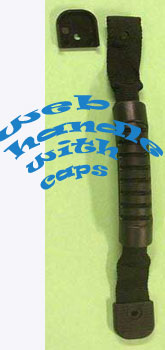| Launching and retrieving my 26' trimaran is never simple despite the improvements I make each year. One autumn was particularly fraught with perils including the tire almost falling off the trailer due to a failed hub. To save time I'll skip ahead to where the boat is in the driveway waiting repair.
The stresses were over, I thought, but then there came a fourth case of "Where has my boat gone?" On my answering-machine was a message asking if my 'punt' was over at MacLean's Beach (which we surmised was on the west side of the harbour). At about that moment another call arrives with the same information, to which I reply, "Impossible, it is sitting on the boat."
A quick trip out with the flashlight shows no dinghy on the deck!
"OOPS, it is not on the boat."
At first light the next morning we make a hurried drove down to the wharf and look out. There on the western sand spit is a tiny dark spot that might be the dinghy. It looks like the strong West wind and rising tide may wash it off and send it back across the harbour. So we hurry home and drive back to the start of the sand spit, covering contingencies with the truck and a set of oars. My wife watches from the truck as I stride out toward the possible dinghy with the oars over my shoulder. The understanding is that she will drive around to the East shore if I am able to launch it and she sees me began rowing across the harbour.
Here are a few photos as it sits at the wharf today.
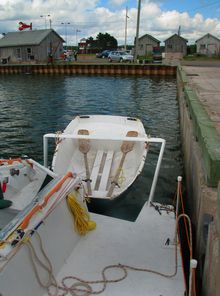 |
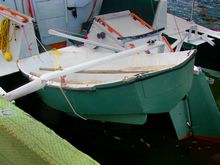 |
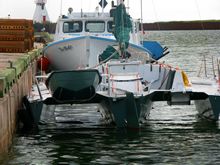 |
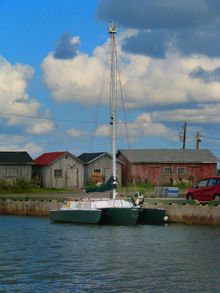 |
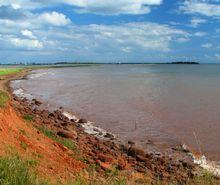 |
 |
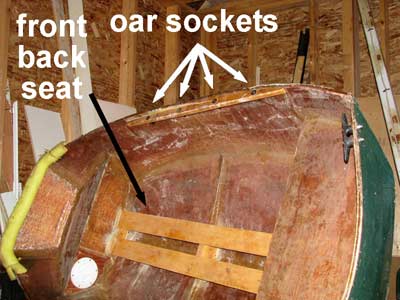 |
It is a good mile hike to the boat-the sand makes the effort even greater and near panic adds speed to my steps. As I get nearer it was apparent that 'spot' is indeed my dark-green dinghy (about 6' long and made out of plywood and epoxy "stitch & glue" construction). The nearer I get the more it seemed it is rocking in the wind and likely to float off before I get there. When I actually arrive I established that 1) it is truly my dinghy, 2) it isn't going anywhere - it is solidly in the sand and full of water. I cannot even budge it until I use an oar to splash the water out of it. The bottom has is filled with about 12" of sand beneath the water - a sort of bathtub planter. With the water out I am able to tip it over and empty most of the sand. Shed of its contents I am able to drag it the 20' to the water, but wait, what about the flotation chambers? The front one is full of water and the rear has a couple of inches as well. I don't want to risk crossing the harbour without that safety feature, so I twist off the covers and tip it over to drain. Finally, I put the oars back in and launch the boat.
The strong West wind is now almost directly behind me and kicking up waves as it clears the sand spit. To reach the best landing place on the East side, I have to quarter the wind for a bit and then go straight downwind across the ferry channel to a landing place that can be reached by the truck. The tiny boat bobs over the waves without difficulty. The fetch was too short to build really large waves in the harbour. Rowing in big waves is actually fun if you are not at risk of being blown out to sea. Unlike with a large boat, a tiny dinghy bobs up over the waves and would only be at risk if a big wave broke just as it was passing. As I approach the landing I saw the truck zipping around to meet me. Loaded into the truck the dinghy is soon home where it belonged.
As I look back on the event, the biggest wonder is how the dinghy got missed to start with. I am 'sure' it was tied to the sailboat when the latter was being floated onto the trailer. I vaguely remember doing something about the dinghy so it wasn't dragged up by its rope when the sailboat was hauled up, but I don't have any certain recollection past that. The poor dinghy must have wandered around the harbour for about 2 weeks, driven by the winds and tide until it finally ran aground at a high tide and got locked in. It is amazing to think how well it stood up to all that pounding after it was locked in.
Note the dinghy in question is held up under a 2x4 glassed/epoxy-covered frame by blocks (pulleys) where it can be lowered just between the hulls for easy boarding. The shore scenes are of the sand spit (which actually connects to one of the islands of 'Wood Islands') where it was found buried in sand.
|



